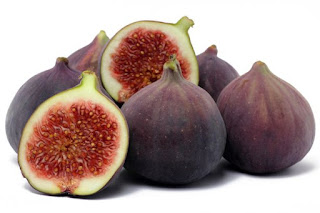Figs (Ficus carica) are among the juiciest, sweetest and most fragrant fruits of late summer. They also have a rich history – mentioned in the Bible, they were said to grow in the Garden of Eden and their leaves were allegedly used to cover Adam and Eve’s nakedness.
The fig is believed to have originated in western Asia before being cultivated throughout the Mediterranean and eventually the world.
Figs are bell-shaped with slightly wrinkled, leathery skin. They can be brown, purple, green, yellow or black, and vary in size. Their high sugar content puts figs among the sweetest of fruits. Each fig ‘fruit’ is actually an enclosed flower head containing many tiny flowers and seeds.
Purchasing
Choose clean, dry figs with thin, unblemished skin. A fig’s skin colour makes little difference to its taste; it will range from palest green to deep purple. Figs should be soft and yielding when gently squeezed but still hold their shape. Ripe figs are very delicate, so take care not to squash them when packing them for the trip home.
Keeping
Keeping ripe figs cold will slow deterioration. If you’re not using them immediately, store figs in a plastic bag in the coldest part of the fridge for up to two days. Chilling can spoil the flavour, so remove figs from the fridge to serve at room temperature. Under-ripe figs can be kept at room temperature for one or two days until the flesh softens.
Preparation
Fresh figs are usually eaten raw. They taste best eaten straight off the tree, ideally still warm from the sun. The entire fig is edible, from the thin skin to the red or purplish flesh and the myriad tiny seeds, but they can be peeled if you wish. Always cut off the stem. Wash the figs and gently pat dry to serve whole.
Nutrition
Figs contain small amounts of potassium, magnesium, calcium and vitamin B6, while the many small edible seeds and edible skin means high fibre content. The red-purple skin indicates levels of protective antioxidant phytochemicals.
Varieties
Figs are classified by colour – white, black or red. These are the more popular varieties:
Black Genoa figs:
Have a dark purple skin, white flesh and white and red seeds.
Adriatic figs:
Are known for their pronounced flavour, especially when dried.
Brown Turkey figs:
Are medium to large with a purplish-brown skin and sweet, juicy pulp.
Mission figs:
Are purplish-black with red flesh. They are full-flavoured, with a moist and chewy texture, best eaten fresh.
Calimyrna figs:
Are large, with green skin and white flesh. They have a desirable, honey/nut-like flavour.
Kadota figs:
Are medium-sized with a yellowish-green thick skin. The sweet, white to amber-pink pulp has only a few
Cooking
Make a mouthwatering salad by chopping fresh figs and tossing with shredded rocket leaves, crumbled goat’s cheese and toasted walnuts.
Blend spreadable cream cheese with finely chopped macadamia nuts and a little honey. Spread over thinly sliced prosciutto and wrap around fresh fig halves. Serve.
Thickly slice figs and place in a heatproof baking dish. Drizzle with vanilla custard to just cover. Sprinkle with raw sugar and ground cinnamon. Cook under a hot grill until just warm. Serve immediately.


















No comments:
Post a Comment